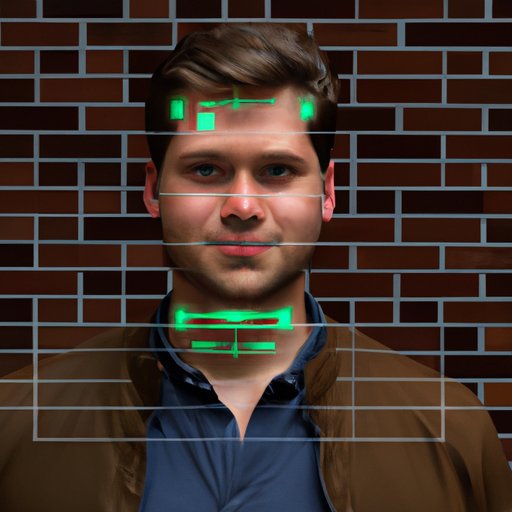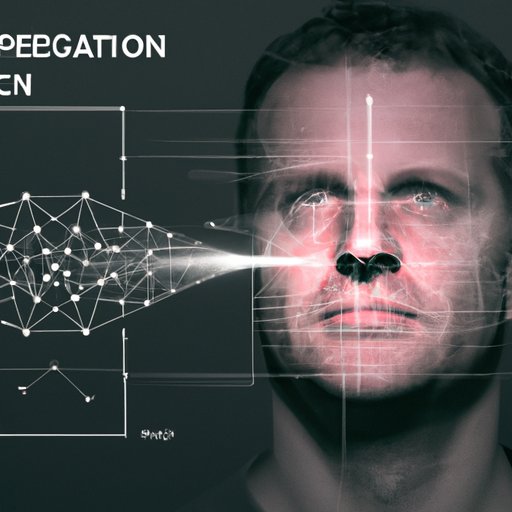Introduction
Facial recognition technology has become increasingly prevalent in the modern world. From security systems to social media applications, facial recognition is being used in a variety of ways to enhance safety, convenience, and efficiency. But what exactly is facial recognition technology and how does it work? This article will explore these questions and more, examining the science behind facial recognition, the different types of software available, the potential benefits and drawbacks, and how it is being used in everyday life.

Exploring the Science Behind Facial Recognition
So, how does facial recognition technology work? According to a study conducted by the University of Cambridge, facial recognition technology “uses algorithms to detect and measure facial features from an image or video.” It then compares this data with a database of known faces to identify individuals. The technology relies on a variety of factors, including the shape of the face, size and location of the eyes, nose, and mouth, as well as other features such as skin tone and hair color.
In order for facial recognition technology to work, it needs certain components. First, it requires a database of images – typically referred to as a ‘biometric template’ – which can be used to compare against the image it is trying to identify. Second, it needs a facial recognition algorithm, which is a computer program that can detect and measure facial features. Finally, it needs a processor to run the algorithm, which can range from a simple microprocessor to a powerful graphics card.

Examining the Different Types of Facial Recognition Software
When it comes to facial recognition software, there are two main types: 2D and 3D. 2D facial recognition uses a two-dimensional image of a person’s face, while 3D facial recognition uses a three-dimensional scan of the face. While both types of software are effective, 3D facial recognition has been shown to be more accurate and reliable than 2D.
Another important factor to consider is the type of machine learning algorithms used in the software. Machine learning algorithms are computer programs that can learn and adapt over time, allowing them to improve their accuracy and performance. For example, some facial recognition software uses convolutional neural networks (CNNs), which are deep learning algorithms that can recognize patterns in visual data. Other software may use support vector machines (SVMs) or other algorithms.

Investigating the Benefits and Drawbacks of Facial Recognition
Facial recognition technology offers a number of potential benefits. For one, it can be used to increase security, as it can be used to identify individuals who are not authorized to enter a building or access certain areas. Additionally, it can be used to streamline processes, such as unlocking a phone or verifying identity for online transactions. Finally, it can be used to detect fraud and other criminal activities.
However, there are also drawbacks to facial recognition technology. One of the biggest concerns is privacy, as facial recognition can be used to track and monitor individuals without their knowledge or consent. Additionally, facial recognition software can be inaccurate, particularly when it comes to recognizing people of color. According to a study by the National Institute of Standards and Technology, some facial recognition software was found to be up to 100 times more likely to misidentify African American and Asian faces than white faces.
Analyzing the Impact of Facial Recognition on Privacy
The potential implications of facial recognition technology on privacy are far-reaching. On the one hand, it can be used to improve safety and security, as it can help to identify criminals or those involved in suspicious activities. On the other hand, it can be used to track and monitor individuals without their knowledge or consent, raising serious concerns about civil liberties and human rights.
There are a few potential solutions to the privacy issues posed by facial recognition technology. One is to ensure that any facial recognition software is subject to strict regulations and guidelines, such as requiring explicit consent before using the technology. Additionally, it could be used in conjunction with other technologies, such as encryption, to further protect the privacy of individuals. Finally, technology companies could implement safeguards to ensure that the data collected is secure and not misused.
Taking a Look at How Facial Recognition is Used in Everyday Life
Facial recognition technology is increasingly being used in everyday life. For example, many smartphone manufacturers have incorporated facial recognition into their devices, allowing users to unlock their phones with just a glance. Additionally, many airports and other public places are using facial recognition technology to speed up security checks.
In addition, facial recognition is being used in a variety of other ways. Social media platforms, such as Facebook, are using facial recognition to identify users in photos and videos. Retail stores are using it to target customers with personalized ads. And law enforcement agencies are using it to identify criminals.
As technology continues to evolve, facial recognition is likely to become even more common in everyday life. In the future, it could be used to power autonomous vehicles, serve as a form of payment, or even replace traditional passwords.
Exploring Future Developments in Facial Recognition Technology
In addition to the current applications of facial recognition technology, there are a number of exciting developments on the horizon. Artificial intelligence is expected to play an increasingly important role in facial recognition, allowing the technology to become even more accurate and efficient. Additionally, biometrics, such as iris scanning and voice recognition, could be used to further enhance the accuracy of facial recognition.
Conclusion
Facial recognition technology is becoming increasingly popular in the modern world. This article has explored how facial recognition technology works, the different types of software available, the potential benefits and drawbacks, and how it is being used in everyday life. As technology continues to evolve, facial recognition is likely to become even more commonplace, with exciting new developments on the horizon.
(Note: Is this article not meeting your expectations? Do you have knowledge or insights to share? Unlock new opportunities and expand your reach by joining our authors team. Click Registration to join us and share your expertise with our readers.)
